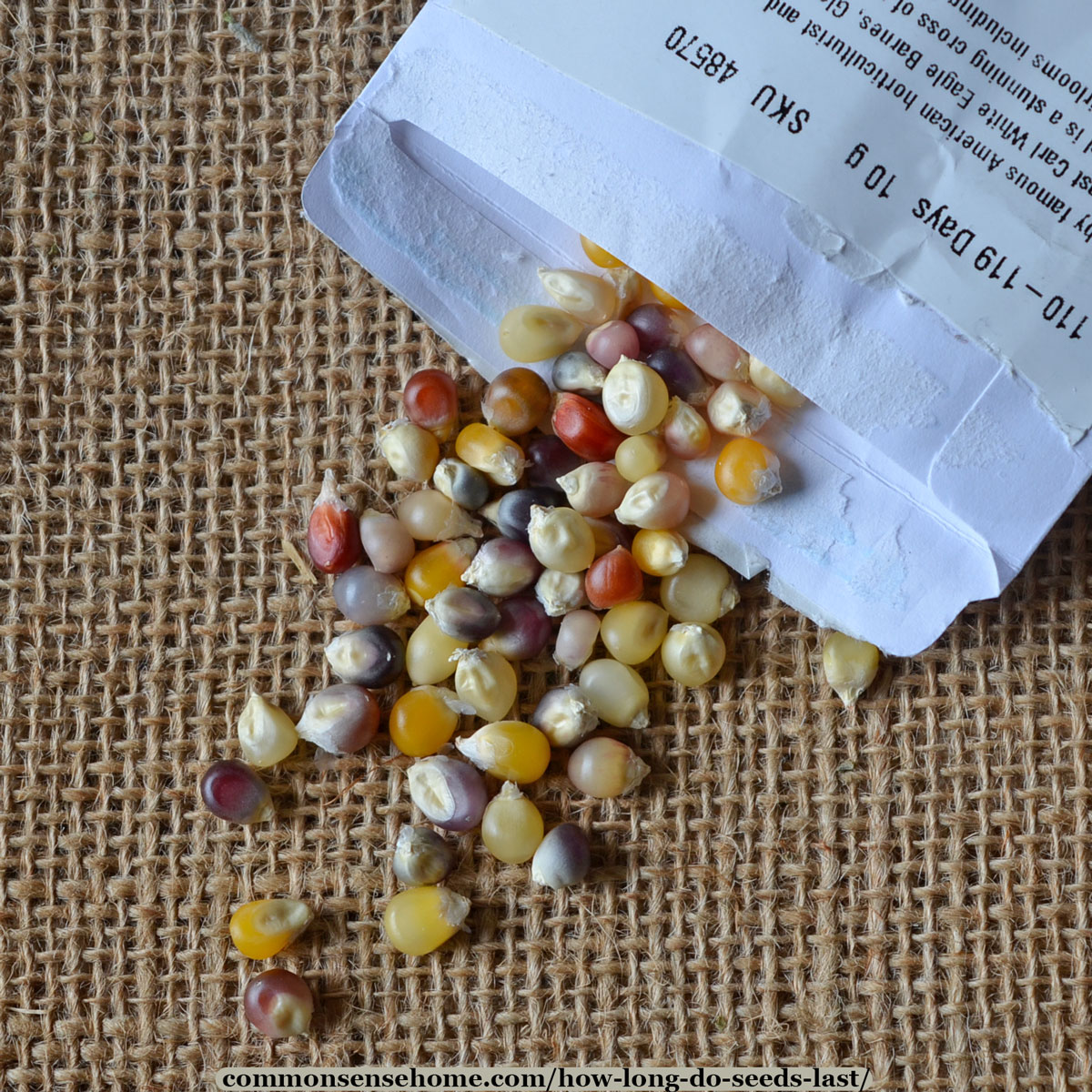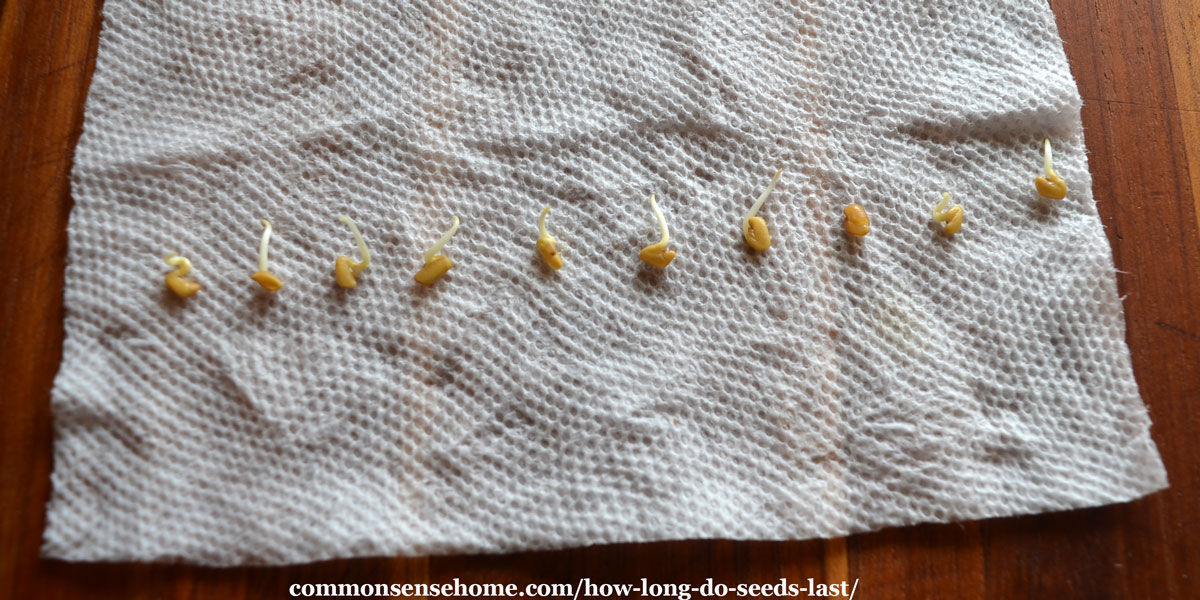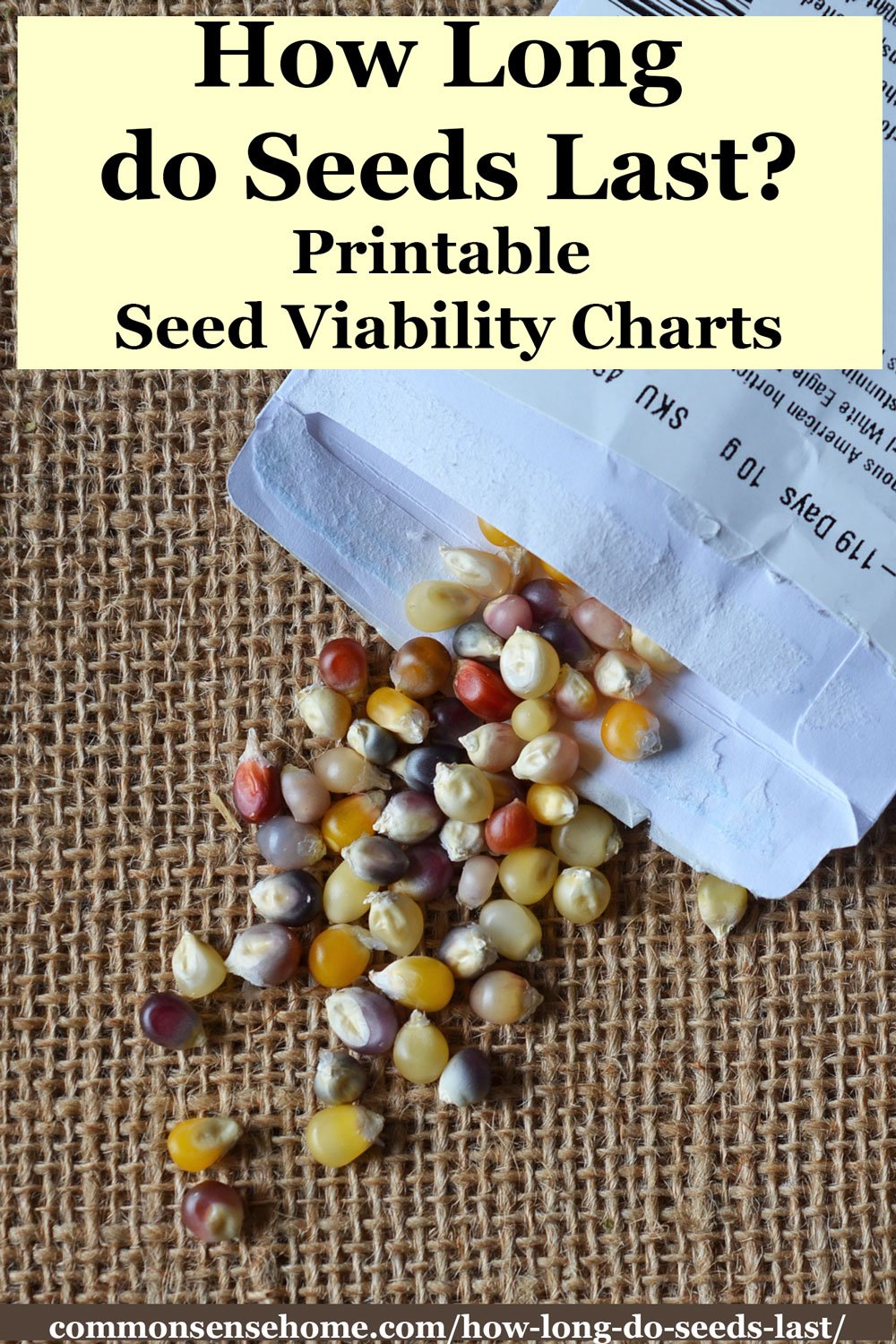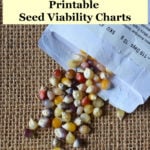How Long do Seeds Last? (w/ Printable Seed Viability Charts)
This post may contain affiliate links. Read my full disclosure here.
How long do seeds last? The oldest seed that’s been grown into a plant is a 2,000 year old date palm, but your garden seeds probably won’t last quite that long. We’ll share seed viability charts, tips for storing seeds, and how to check germination rates.

How Long Do Seeds Last?
How long will seeds stay viable? It depends on the type of seed, and the storage conditions. Most should last at least a couple of years.
The seed viability charts below show typical years that seeds remain viable under cool, dry storage conditions.
Vegetable Seed Viability Chart
| Crop | How Many Years do They Last? | Typical Days to Germination |
|---|---|---|
| Asparagus | 3 | 10 |
| Bean, Lima | 3 | 8 |
| Bean, Snap | 3 | 7 |
| Beets | 4 | 4 |
| Broccoli | 5 | 4 |
| Brussels Sprouts | 5 | 4 |
| Cabbage | 5 | 4 |
| Carrot | 3 | 6 |
| Cauliflower | 5 | 5 |
| Celeriac | 5 | 11 |
| Celery | 5 | 7 |
| Chicory | 5 | 6 |
| Chinese Cabbage | 5 | 4 |
| Cucumber | 5 | 3 |
| Eggplant | 5 | 6 |
| Endive | 5 | 6 |
| Kale | 5 | 4 |
| Kohlrabi | 5 | 4 |
| Leek | 3 | 7 |
| Lettuce | 5 | 3 |
| Muskmelon | 5 | 4 |
| New Zealand Spinach | 5 | 6 |
| Okra | 2 | 6 |
| Onion | 1 – 2 | 6 |
| Parsley | 2 | 13 |
| Parsnip | 1 – 2 | 14 |
| Pea | 3 | 6 |
| Pepper | 4 | 8 |
| Pumpkin | 4 | 4 |
| Radish | 5 | 4 |
| Rutabaga | 5 | 4 |
| Salsify | 2 | 6 |
| Spinach | 5 | 5 |
| Squash | 5 | 4 |
| Sweet corn | 1 – 2 | 3 |
| Swiss Chard | 1 – 2 | 4 |
| Tomato | 4 | 6 |
| Turnip | 5 | 3 |
| Watermelon | 5 | 4 |
Herb Seed Viability Chart
| Plant Type | How many years do they last? |
| Anise | 3 |
| Basil | 5-7 |
| Calendula | 3 |
| Catnip | 5 |
| Chives | 1 |
| Cilantro | 5-7 |
| Dill | 3 |
| Fennel | 4 |
| Lavender | 5 |
| Oregano | 2 |
| Parsley | 1 |
| Sage | 3 |
| Savory | 3 |
| Thyme | 3 |
Flower Seed Viability Chart
| Plant Type | How many years do they last? |
| Ageratum | 4 |
| Alyssum | 4 |
| Amaranth | 4 |
| Aster | 1 |
| Baby’s Breath | 2 |
| Bachelor’s Button | 3 |
| Calendula | 5 |
| Celosia | 4 |
| Clarkia | 2 |
| Coleus | 2 |
| Columbine | 2 |
| Cosmos | 3 |
| Dahlia | 2 |
| Daisy | 3 |
| Delphinium | 1 |
| Dianthus | 4 |
| Foxglove | 2 |
| Geranium | 1 |
| Hibiscus | 3 |
| Hollyhock | 3 |
| Impatiens | 2 |
| Larkspur | 1 |
| Lobelia | 3 |
| Lupine | 2 |
| Marigold | 2 |
| Naturtium | 3 |
| Nicotiana | 3 |
| Pansy | 2 |
| Petunia | 3 |
| Phlox | 1 |
| Poppy | 4 |
| Salvia | 1 |
| Snapdragon | 3 |
| Sweet Pea | 3 |
| Verbena | 1 |
| Zinnia | 5 |
When you’re sorting through your saved seeds, you might want to mark the life expectancy on the seed packets to save time in the future.
My seeds often last longer than the expected storage times, but not always. For instance, I had one variety of 10 year old tomato seeds that came up great. With another variety, only one seed germinated out of ten.
I keep records for the seedlings I start inside, listing planting date, variety, germination rate, and other data. This allows me to keep track of whether or not I probably need fresh seeds, even if I have a lot left over.
You can get a copy of this and the other garden planning charts I use with your Common Sense Home newsletter subscription.
Would you like to save this?

Seed Storage Tips
Keep your saved seeds cool and dry, out of direct light and protected from pests. For mid-length storage, a cool closet shelf or basement cabinet will do. Avoid the kitchen, garage, or shed – the temperature changes too much.
If you want to try a home version of a long term seed vault, opt for an airtight container in the chest freezer. Chest freezers have less temperature swings than refrigerators or upright freezers. Bring your seed container to room temperature before opening it to avoid condensation on your seeds.
For more details, see “How to Store Seeds (for Next Year or Long Term)“,
Simple Germination Test
Before you hit the seed catalogs for fresh seeds, it doesn’t hurt to test the seeds to see if they are viable with a simple germination test.
Moisten a paper towel or coffee filter, and place ten seeds on it. Fold the damp paper over the seeds and place it in a plastic bag or glass jar. Keep it warm and moist.
Check the seeds every two to three days for signs of germination. Some will germinate quickly, others may take 2-3 weeks. (Your seed packet may have information on expected time to germination. We have it listed in the charts for vegetables.)

As long as you have some viable seeds, go ahead and use them. If germination rates are poor, plant seeds a LOT more thickly, or buy fresh seeds.
If you have a small garden, consider sharing seeds with friends to keep your stash fresh. When germination rates are low, you can try planting the seeds in an out of the way corner of the garden to see if they grow.
More Gardening Articles
We have over 100 gardening articles on the site, including:
How to Start a Garden – 10 Steps to Gardening for Beginners
Companion Planting in the Garden (The Easy Way) – Includes Printable Chart
10 Heirloom Seed Companies You Don’t Want to Miss



Also new to your site wqs looking for winter rye data had to by a lot more then what i needed curious has how to preserve it for future use Iuse as a cover crop in garden over winter
Like other seeds, cool and dry conditions are best for storage, with protection from bugs and rodents.
Planting depth is 1 to 2 inches deep. Plant in late summer/early fall at a rate of 8 to 10 ounces per 100 square feet of garden.
Either till, broadcast and rake in, or rake off course mulch, broadcast, and rake in.
New to your site but already loving it. Just thought I would share that I like to use the paper towel germination process as well. Depending on the seed type, I will often put the sprouted seeds in my starter pots in early season for seeds that need a warming pad. Since I don’t use a warming pad; this is as close to guaranteeing they will continue to sprout and start growing.